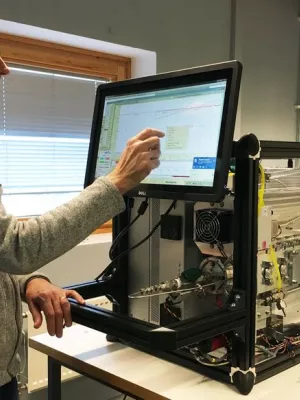
Erik Swietlicki
Professor

Towards an online-coupled chemistry-climate model: evaluation of trace gases and aerosols in COSMO-ART
Author
Summary, in English
The online-coupled, regional chemistry transport model COSMO-ART is evaluated for periods in all seasons against several measurement datasets to assess its ability to represent gaseous pollutants and ambient aerosol characteristics over the European domain. Measurements used in the comparison include long-term station observations, satellite and ground-based remote sensing products, and complex datasets of aerosol chemical composition and number size distribution from recent field campaigns. This is the first time these comprehensive measurements of aerosol characteristics in Europe are used to evaluate a regional chemistry transport model. We show a detailed analysis of the simulated size-resolved chemical composition under different meteorological conditions. Mean, variability and spatial distribution of the concentrations of O-3 and NOx are well reproduced. SO2 is found to be overestimated, simulated PM2.5 and PM10 levels are on average underestimated, as is AOD. We find indications of an overestimation of shipping emissions. Time evolution of aerosol chemical composition is captured, although some biases are found in relative composition. Nitrate aerosol components are on average overestimated, and sulfates underestimated. The accuracy of simulated organics depends strongly on season and location. While strongly underestimated during summer, organic mass is comparable in spring and autumn. We see indications for an overestimated fractional contribution of primary organic matter in urban areas and an underestimation of SOA at many locations. Aerosol number concentrations compare well with measurements for larger size ranges, but overestimations of particle number concentration with factors of 2-5 are found for particles smaller than 50 nm. Size distribution characteristics are often close to measurements, but show discrepancies at polluted sites. Suggestions for further improvement of the modeling system consist of the inclusion of a revised secondary organic aerosols scheme, aqueous-phase chemistry and improved aerosol boundary conditions. Our work sets the basis for subsequent studies of aerosol characteristics and climate impacts with COSMO-ART, and highlights areas where improvements are necessary for current regional modeling systems in general.
Department/s
- Nuclear physics
- MERGE: ModElling the Regional and Global Earth system
Publishing year
2011
Language
English
Pages
1077-1102
Publication/Series
Geoscientific Model Development
Volume
4
Issue
4
Document type
Journal article
Publisher
Copernicus GmbH
Topic
- Subatomic Physics
Status
Published
ISBN/ISSN/Other
- ISSN: 1991-959X